.NET Aspire vs ABP Studio: Side by Side
In this article, I will compare .NET Aspire by ABP Studio by explaining their similarities and differences.
Introduction
While .NET Aspire and ABP Studio are tools for different purpose with different scope and they have different approaches to solve the problems, many developers still may confuse since they also have some similar functionalities and solves some common problems.
In this article, I will clarify all, and you will have a clear understanding of what are the similarities and differences of them. Let's start by briefly define what are .NET Aspire and ABP Studio.
What is .NET Aspire?
.NET Aspire is a cloud-ready framework designed to simplify building distributed, observable, and production-ready applications. It provides a set of opinionated tools and NuGet packages tailored for cloud-native concerns like orchestration, service integration (e.g., Redis, PostgreSQL), and telemetry. Aspire focuses on the local development experience, making it easier to manage complex, multi-service apps by abstracting away configuration details.
Here, a screenshot from .NET Aspire dashboard that is used for application monitoring and inspection:

What is ABP Studio?
ABP Studio is a cross-platform desktop application designed to simplify development on the ABP Framework by automating various tasks and offering a streamlined, integrated development environment. It allows developers to build, run, test, monitor, and deploy applications more efficiently. With features like Kubernetes integration and support for complex multi-application systems, ABP Studio enhances productivity, especially in microservice or modular monolith architectures.
Here, a screenshot from the ABP Studio Solution Runner panel that is used to run, browse, monitor and inspect applications:
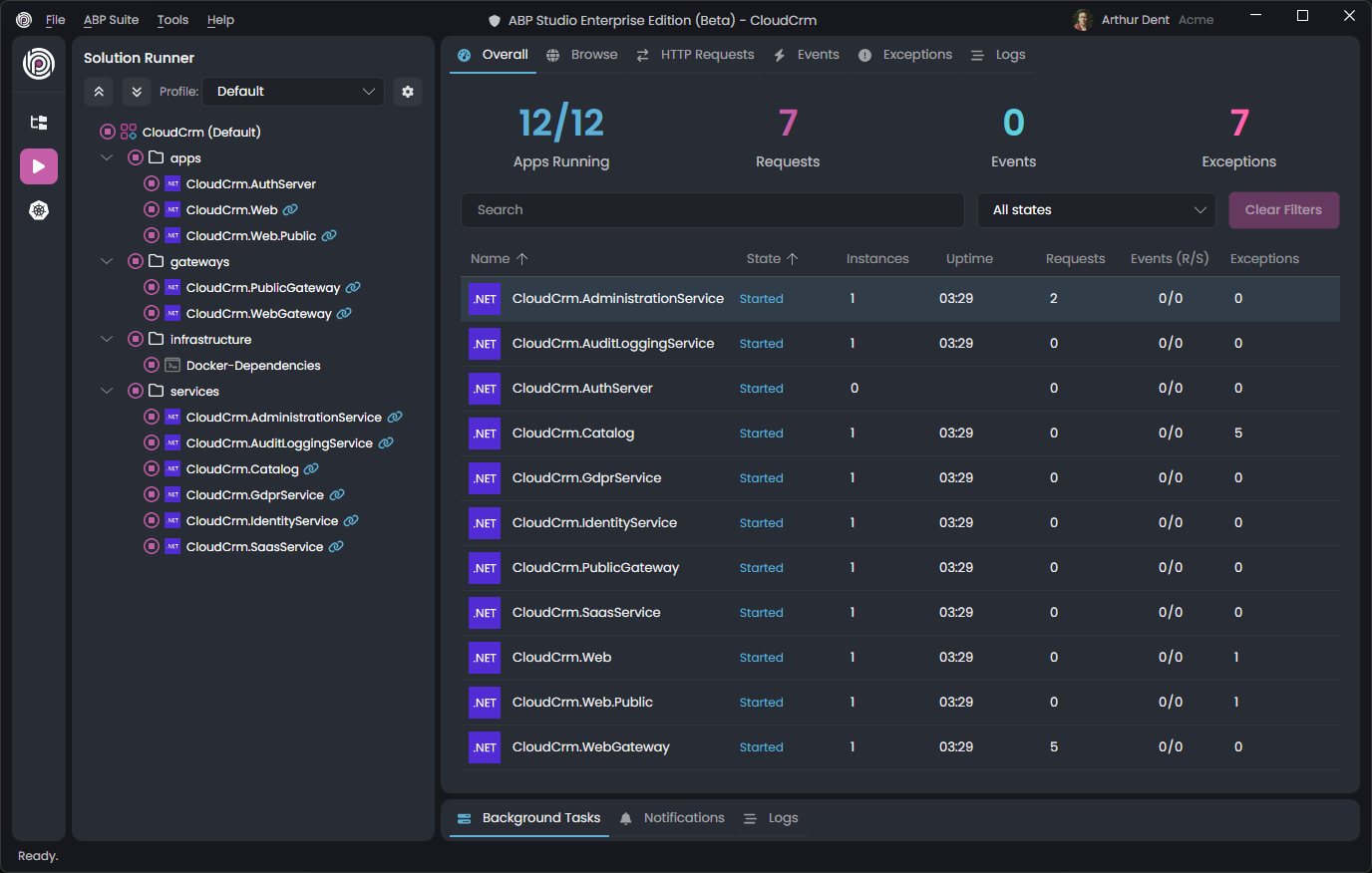
A Brief Comparison
Before deep diving details, I want to show a table of features to compare ABP Studio and .NET Aspire side by side:
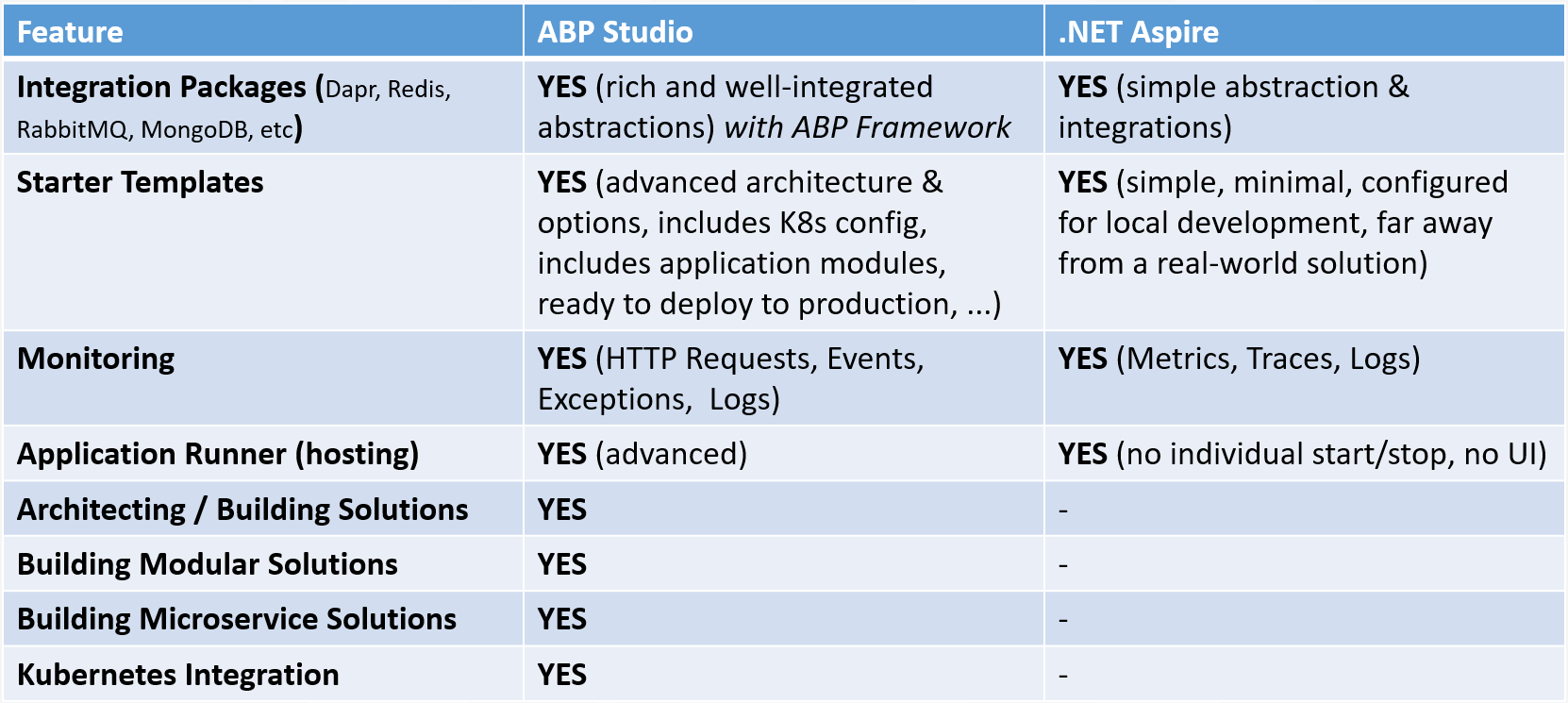
Comparing the Features
In the next sections, I will go through each feature and explain differences and similarities.
Integration Packages
ABP Framework has tens of integration packages to 3rd-party libraries and services. .NET Aspire also has some library integrations. But these integrations have different purposes:
- ABP Framework's integrations (like MongoDB, RabbitMQ, Dapr, etc) are integrations for its abstractions and aimed to be used directly by your application code. They are complete and sophisticated integrations with the ABP Framework and your codebase.
- .NET Aspire's integrations (like MongoDB, RabbitMQ, Dapr, etc), on the other hand, for simplifying configuration, service discovery, orchestration and monitoring of these tools within .NET Aspire host. Basically, these are mostly for integrating to .NET Aspire, not for integrating to your application.
For example, ABP's MongoDB integration allows you to use MongoDB over repository services, automatically handles database transactions, audit logs, event publishing on data saves, dynamic connection string management, multi-tenancy integration and so on.
On the other hand, .NET Aspire's MongoDB integration basically adds MongoDB driver library to your .NET Aspire host application and configures it so you can discover MongoDB server on runtime, use a MongoDB Docker container and see its health status, logs and traces on .NET Aspire dashboard.
Starter Templates
Both of ABP Studio and .NET Aspire provide startup solution templates for new applications. However, there are huge differences between these startup solution templates and their purpose are completely different.
- ABP Studio provides production-ready and advanced solution templates for layered, modular or microservice solution development. They are well configured for local development and deploying to Kubernetes and other production environments. They provide different UI and database options, many optional modules and configuration. For example, you can check the microservice solution template to see how sophisticated it is.
- .NET Aspire's project templates' main purpose is to provide a minimal application structure that is pre-integrated to .NET Aspire libraries and configured for local development environment.
So, when you start with .NET Aspire project template, you will need to deal with a lot of work to make your solution production and enterprise ready. On the other hand, ABP Studio's solution templates are ready to launch your system from the first day and they provide you a perfect starting point for your new business idea.
Monitoring & Application Running
Monitoring applications and services is an important requirement for building complex distributed systems. Both of ABP Studio and .NET Aspire provide excellent tools for that purpose.
- ABP Studio's Solution Runner panel provides a powerful UI to run and monitor applications and services. You can see all HTTP requests, distributed events, exceptions and detailed application logs, trace and find problems in your system. You can use its fully functional built-in browser to navigate application UIs easily. You can also create multiple profiles to group and configure the applications for different teams.
- .NET Aspire's dashboard can be used to see the states of the running applications and containers, explore their console output, logs, traces and metrics to understand what is happing in your distributed system.
Both tools are pretty useful for monitoring. In addition to monitoring, ABP Studio offers an advanced UI to control the running applications, build, start and stop individually or by a group of applications.
Architecting / Building Solutions
One of the unique features of ABP Studio is that it is an architectural tool that helps you create the structure and architecture of your solution. You can create any kind of application, from single-layer simple web applications to layered multi-application solutions, from monolith modular to microservice systems. In the next section, I will briefly explains these architectural features.
Building Modular Monolith Solutions
With ABP Studio, you can create a new solution, create modules and establish relations (dependencies) between modules to architect your overall modular monolith system easily.
Here, a screenshot where we are adding an existing package reference to the Products module of a modular CRM solution:
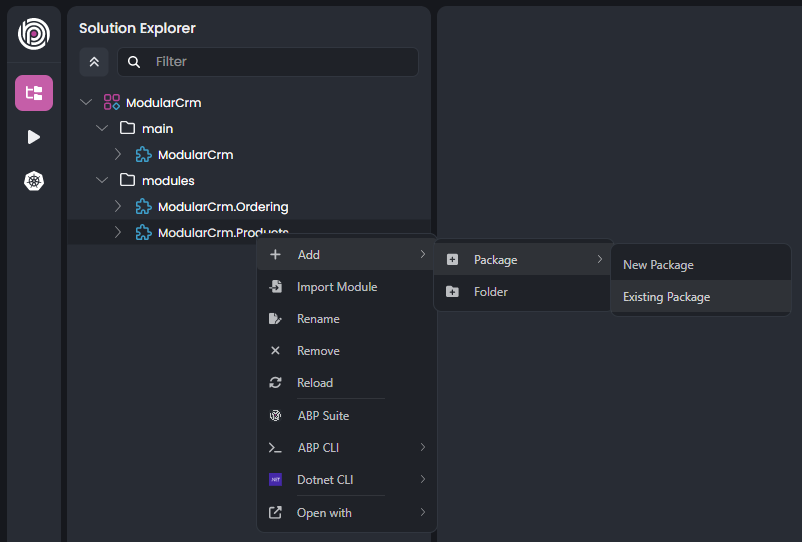
You can see the Modular Application Development tutorial to learn how to build such an application step by step.
Building Microservice Solutions
ABP Studio provides a full featured microservice startup solution template and the fundamental tooling to build large-scale microservice systems.
Here a screenshot that shows how to add new microservices, API gateways or web applications to a microservice solution:
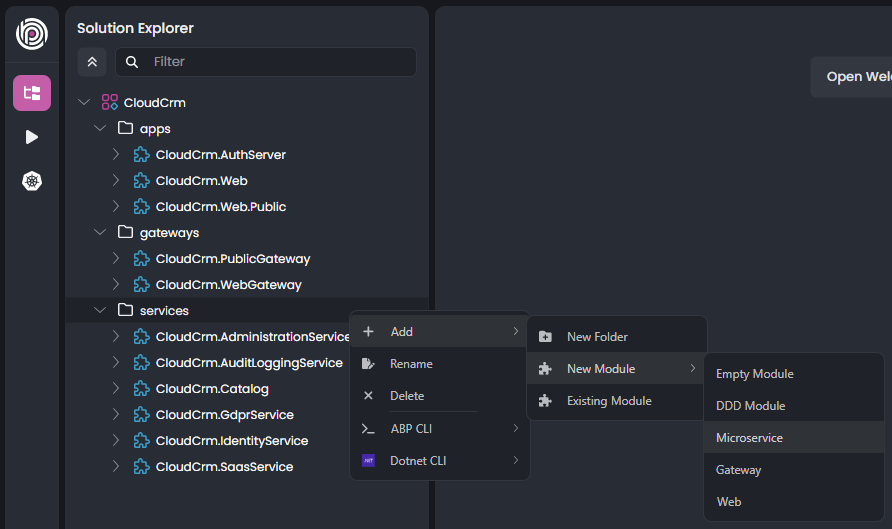
.NET Aspire has no such a feature and has no such a plan to provide that kind of architectural solution building experience.
Kubernetes Integration
Another great ABP Studio feature is Kubernetes Integration. It allows you to develop your distributed / microservice solutions as integrated to Kubernetes.
Here, a few tasks you can accomplish using ABP Studio's Kubernetes integration:
- Build docker images of your applications and services
- Install and uninstall Helm charts to your Kubernetes cluster
- Connect to internal services of your Kubernetes cluster
- Monitor services and applications that are running in your Kubernetes cluster
- Intercept traffic of a service and redirect requests to your local machine. In that way, you can develop, test and run individual services or applications in your local computer that is fully integrated to other services and applications running in Kubernetes.
ABP Studio's Kubernetes Integration makes microservice development so easy and comfortable. On the other hand, .NET Aspire has no such a Kubernetes integrated development experience.
The ABP Platform
Until now, I directly compared ABP Studio and .NET Aspire features. .NET Aspire is directly built on .NET and ASP.NET Core. However, ABP Studio is not a standalone tool that is built on .NET and ASP.NET Core. It is built on the ABP Platform (which is built on .NET and ASP.NET Core).
The following diagram shows ABP Platform components at a glance:
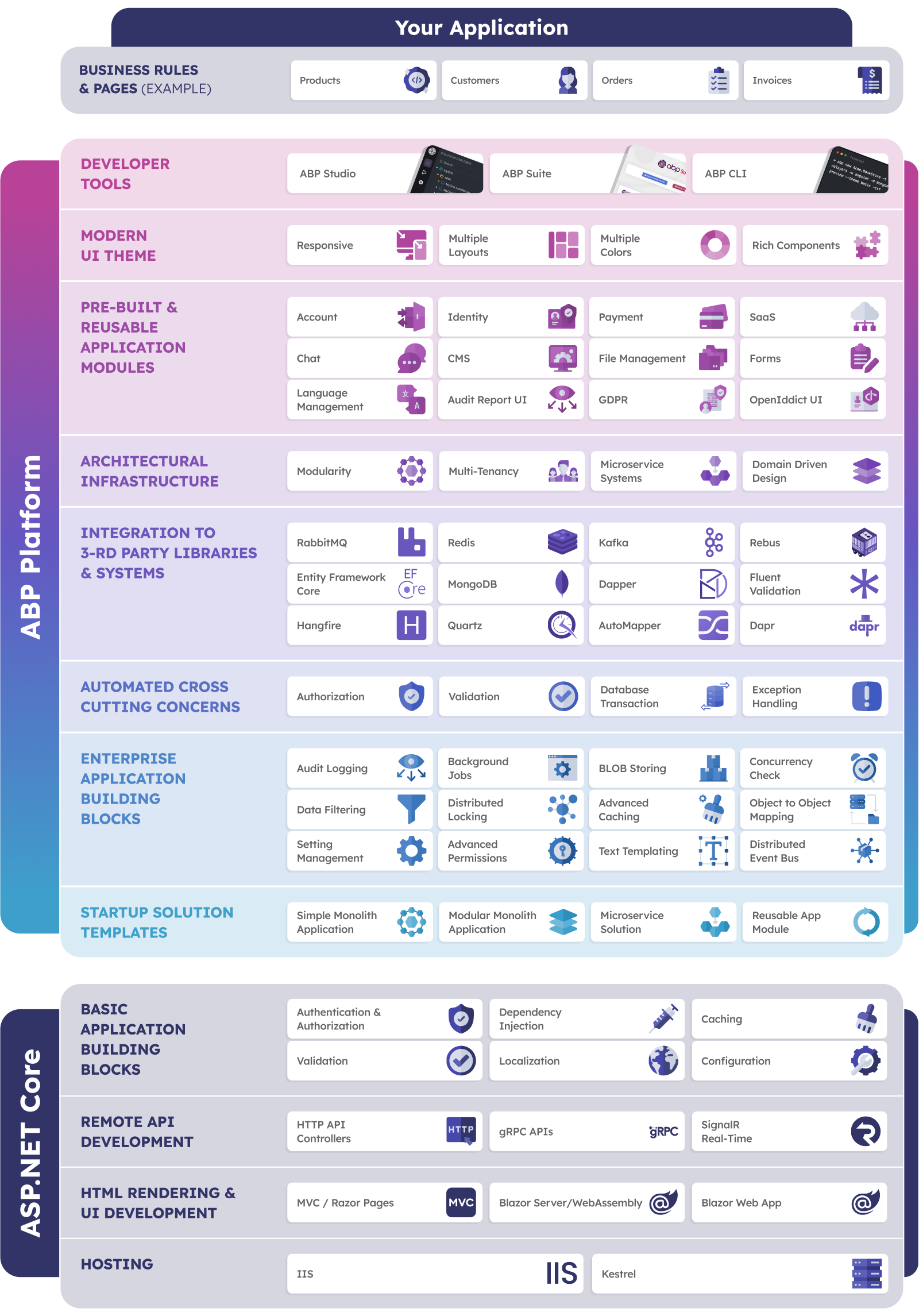
So, when you use ABP Studio, you also take full power of the open source ABP Framework and other ABP Platform features.
ABP and .NET Aspire Integration
I have a good news to you. It is actually possible and pretty easy to make ABP Platform and .NET Aspire working together.
You can check @berkansasmaz's great article: How to use .NET Aspire with ABP framework.
Licensing
ABP Studio has a Community Edition which is completely free and available to everyone. It includes many of the features I mentioned here. There is also a commercial edition that is included in commercial ABP licenses. You can check that blog post which clearly explains the license differences and introduces the fundamental ABP Studio features.
On the other hand, .NET Aspire is a free tool developed and published by Microsoft. It has no commercial version.
Conclusion
Both .NET Aspire and ABP Studio serve distinct purposes, catering to different types of development environments. While .NET Aspire excels in simplifying cloud-native application setups and observability, ABP Studio provides a comprehensive framework for modular monoliths and microservice architectures with full-fledged enterprise level production-ready startup solution templates and integrated tools.
In the previous section, it was mentioned that it is possible to use them together. You don't have to select one of them. However, in my opinion, when you use ABP Studio, you won't need .NET Aspire since ABP Studio can do everything and much more. If you have budget, I suggest to purchase a commercial ABP Studio license so you can fully unlock its power.


























































Comments
Engincan Veske 62 weeks ago
Great article! It's great to see the differences clearly between the ABP Studio and .NET Aspire. ABP Studio provides a complete road-map for application development (from starting with a solution to deploying it to k8s - end to end process), on the other hand, .NET Aspire provides a dashboard to show applications states, and provides simple functionalities such as service discovery, and some common integration packages, which is already provided by the ABP.
Great job team! it seems the .NET team should work hard to fill the gap :)
Serdar Genc 62 weeks ago
Abp Studio is the best work Volosoft has done recently.
Halil İbrahim Kalkan 62 weeks ago
Thank you :)
Alper Ebiçoğlu 62 weeks ago
A nice article explaining Microsoft's popular Aspire and Volosoft's Studio in a side-by-side comparison
Sergei Gorlovetsky 62 weeks ago
Excellent article, it clarified the differences and commonalities of ABP Studio and Aspire. It might be fair to say that Aspire aspires to become ABP Studio :)
Halil İbrahim Kalkan 62 weeks ago
Thank you. Haha, nice point. We started the ABP Studio project before .NET Aspire. It is good to see that Microsoft also sees the same problems and is trying to find solutions.
Berkan Şaşmaz 61 weeks ago
Thank you for mentioning my article! While both tools bring valuable capabilities to the table, I believe they serve different purposes and cater to distinct needs. It's exciting to see comparisons like this, helping developers choose the right tool for their specific requirements.
Jack Fistelmann 61 weeks ago
We are thinking about migrating from tye to something like aspire or abp studio. but does it support something like global package versions (where you have one file defining the versions of packages) or variables like "$abpVersion" which is something like "8.3.2"?
Halil İbrahim Kalkan 61 weeks ago
You can do it yourself, pretty easy. We can consider to add that to solution templates in the future. However, ABP studio and ABP CLI can also automatically upgrade all ABP related NuGet and NPM packages whenever a new ABP version is released. See docs: https://abp.io/docs/latest/cli#update
beratcarsi 56 weeks ago
Thanks a lot for detail explain.
duyan11110 38 weeks ago
Thanks for your post. I think, it will be better if ABP Studio can run offline in isolated env. Do you have plan to do that?
Halil İbrahim Kalkan 38 weeks ago
No plan for that yet.